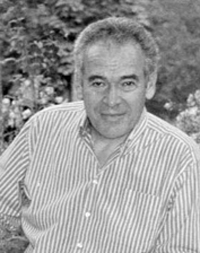 |
Alejandro D. Rey
McGill University
Hougen Visiting Professor
Alejandro D. Rey received his B.S. in chemical engineering from the City College of New York in 1985, where he was salutatorian of the college. He earned his Ph.D. In chemical engineering at the University of California, Berkeley under the supervision of Professor Morton Denn in 1988. Dr. Rey has been a faculty member at McGill University since 1988 and is now professor of chemical engineering and executive member of the McGill Advanced Materials Institute. He is a member of the McGill Center for Nonlinear Dynamics in Physiology and Medicine, the McGill Center for Self-Assembled Chemical Structures, the NSF-Engineering Research Center for Advanced Fibers and Films at Clemson University, and serves on the editorial board of Design and Nature. He has authored over 240 refereed papers and book chapters, and given close to 50 invited talks.
Professor Rey's accomplishments have been recognized through several professional awards, including the James McGill Chair in Chemical Engineering, and the 1993 Class of '51 Outstanding Teacher Award from McGill's Faculty of Engineering. Five of his former graduate students and postdoctoral fellows are engineering academics in Japan, South Korea, Brazil, and Canada.
Hougen Lectures, Fall 2006
COMPUTATIONAL MATERIALS SCIENCE OF LIQUID CRYSTALS
Tuesday, September 26 at 4:00 p.m. (refreshments at 3:45 p.m.)
Room 1800 Engineering Hall
Liquid crystals are orientationally ordered soft phase materials with many functional and structural applications. Understanding and optimizing the functionality and processability of these anisotropic, textured, viscoelastic materials requires the integrated use of optics, rheology, interfacial science, phase transitions, defect physics and topology. Computational materials science is a methodology based on the integration of all these disciplines. I will discuss several challenges in liquid crystal research in which computational materials science has helped to elucidate structure and dynamics relevant to functionality and processability.
Processing of liquid crystalline polymers to produce fibers involves flow-induced texturing, pattern formation, and texture transformation through defect nucleation and annihilation. I will discuss how computational rheooptics together with defect physics and bifurcation theory yield quantitative information on orientation field symmetry, defect density, and rheological functions, as well as inverse problems, such as extracting heterogeneous orientation information from optical signals.
Carbonaceous mesophases are discotic liquid crystals used as precursors for carbon super-fibers, composites, foams, and nanofibers. Mesophase orientation and self-assembly under non-planar confinement invariably leads to characteristic heterogeneous textures and defect lattice structures. I will discuss the use of phase ordering models, computational reflection polarized microscopy, and differential geometry to develop an understanding of how defect lattices and orientation heterogeneities arise under confinement.
Texturing by chemical, electrical, and geometrical heterogeneities of substrates in contact with liquid crystals can be detected by transmitted optical microscopy, an optoelastic process known as liquid crystal vision. I will present progress and challenges in computational polarized optical microscopy of textured liquid crystals based on Maxwell equations and device models based on liquid crystal vision.
MODELING LIQUID CRYSTAL MATERIALS AND PROCESSES IN BIOLOGICAL SYSTEMS
Tuesday, November 21 at 4:00 p.m. (refreshments at 3:45 p.m.)
Room 1800 Engineering Hall
Liquid crystal phases are found in DNA, proteins, lipids and polysaccharides. Frozen-in, chiral liquid crystal ordering also occurs in solid biocomposites such as insect cuticle, muscle, plant cell walls and collagen, where the helicoid structure is believed to arise by self-assembly processes. Spinning of silk fibers by spiders is another biological polymer process that relies on liquid crystal self-assembly. I will discuss the progress and challenges of modeling in three such applications:
- Biological helicoids form by directed self-assembly. Theory and computer simulation of chiral phase ordering show that the directed self-assembly process reproduces the natural structures. The computational results shed light on the role of chiral ordering on the formation of helicoidal monodomains.
- Spinning of spider silk involves a complex sequence of phase transitions that includes nematic phase ordering in the duct section of the spinning apparatus. Simulation of phase ordering under capillary confinement replicates the observed structures found in Nephila clavipes and other orb-weavers. The computational results shed light on the role of defect textures in the fiber spinning process.
- Biological membranes are smectic liquid crystals that display flexoelectricity, or coupling between electric fields and curvature. Models based on smectic elasticity and polarization thermodynamics are used to derive the electroelastic shape equation, whose solution gives the membrane shape under external fields. The theoretical results shed light on the various ways electric fields affect membrane shape and functioning.
